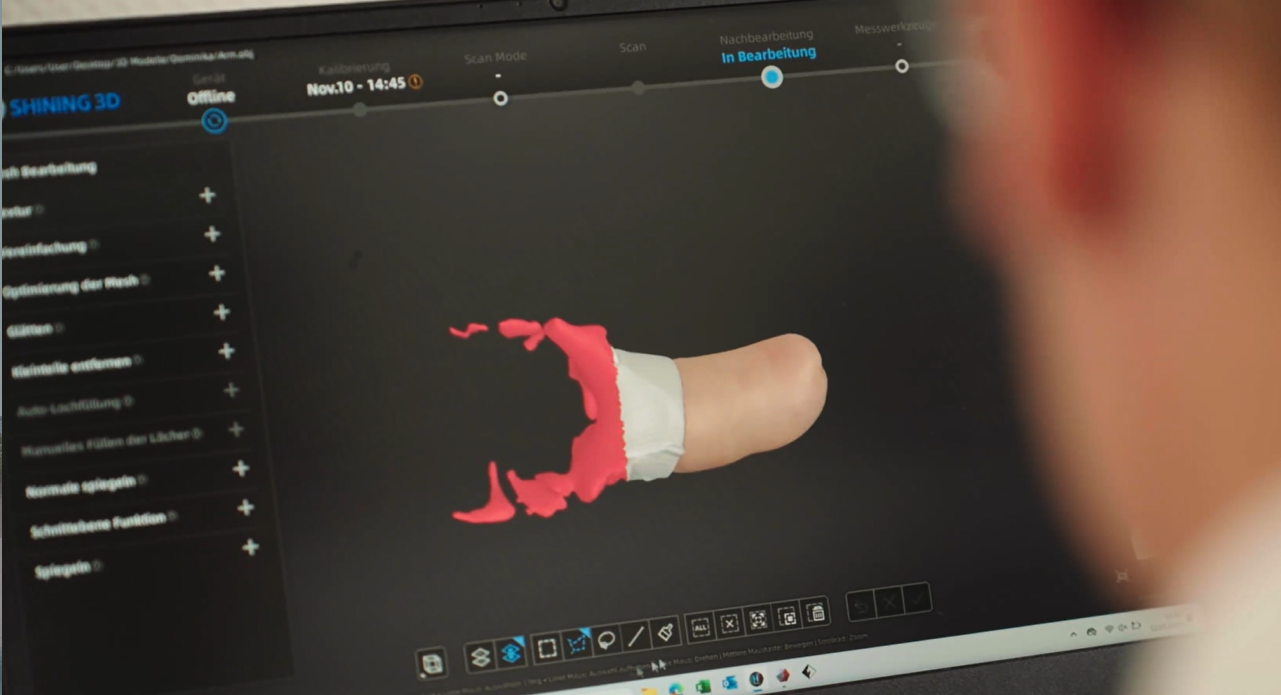
CASE STUDIES
Published on May 27th 2025
Lammert Scherer: Driving 3D Technology Standardization in Orthotics and Prosthetics
Discover how Lammert Scherer GmbH uses SHINING 3D’s EinScan H2 and AccuFab L4K to streamline prosthetic design, ensure accuracy, and enhance patient comfort through digital workflow.
In the field of orthotics and prosthetics, precision and comfort are critical for providing patients with effective and personalized aids. For Lammert Scherer GmbH, a German company with deep expertise in orthopedic and prosthetic technology, and a particular focus on rare diseases. By adopting SHINING 3D’s scanning, modeling, and printing solutions, the company has streamlined its workflow, enhancing accuracy, efficiency, and patient comfort in the design of personalized medical devices. 3D technology has become more standardized and deeply embedded in their daily operations.
About Client
- Customer Name: Mike Unmacht (Master Orthopedic Technician)
- Company: Lammert Scherer GmbH
- Location: Germany
- Need: An easy, accurate, and flexible solution for orthotics and prosthetics design and manufacturing
- Solutions: EinScan H2, AccuFab L4K

Logo of Lammert Scherer GmbH
Challenge: Traditional Modeling Methods Limit Flexibility and Reproducibility
Plaster models are the modeling method used by Lammert Scherer GmbH. “If take a plaster model, and add plaster to it, need alter the original.” said Mike Unmacht. If you want to make local adjustments or modifications, you have changed the original model and cannot restore it to its original state. Once a plaster model has been modified or damaged, it loses the data it was originally acquired with and can never be “rolled back” or reused as is.
For highly customized solutions, such as electric arm prostheses, this inflexibility becomes a serious barrier. Additionally, working with patients in sensitive conditions, such as those in intensive care units, makes contact-based measurement techniques impractical or even impossible.
There was a clear need for a contactless, accurate, and repeatable method to collect and manage patient data for device creation.
A Complete Digital Workflow with 3D Scanning, Software, and Printing
To overcome these limitations, Lammert Scherer GmbH implemented a streamlined digital workflow for electric arm prostheses powered by SHINING 3D:
- Electrode Point Identification: The electrode positions are first determined directly on the patient’s skin.

Scan the forearm by EinScan H2
- 3D Scanning: The forearm is captured using SHINING 3D’s EinScan H2. The contactless scan ensures patient comfort while providing accurate geometry.

Model the prosthetic socket in SHINING 3D’s software
- Digital Modeling: The 3D scan is processed in software, where technicians model a customized prosthetic socket tailored to the patient’s anatomy and electrode map.

The socket is 3D printed with the AccuFab L4K
- Rapid Prototyping with 3D Printer: This step enables real-world verification of fit and electrode alignment on the patient.

Patient test to check whether the socket is meet the specification
Once the socket is fitted and confirmed, the finalized 3D data is shared with Open Bionics, who use it to produce the final prosthetic arm.
Benefit: Accuracy, Repeatability, and Comfort
- Reproducibility and Traceability: The ability to preserve and reference the original digital scan ensures consistent design iterations and supports long-term patient care.
- Enhanced Accuracy: High-resolution scanning captures electrode locations and anatomical details with sub-millimeter accuracy, directly supporting more precise 3D modeling and socket design.
- Time Savings: 3D scanning eliminates lengthy manual casting and measurement steps, and 3D digital models enable instant design modification and adjustments, significantly accelerating both prototyping and final production of prosthetics.
- Improved Patient Comfort: Contactless scanning and customized fit using elastic or semi-elastic printed parts enhance wearability and compliance.
- Streamlined Collaboration: The final digital file can be seamlessly shared with third-party partners like Open Bionics, accelerating production and reducing potential errors in data transfer.
Conclusion
The integration of SHINING 3D’s digital technologies into Lammert Scherer GmbH’s workflow marks a significant advancement in orthopedic and prosthetic care. From precise 3D scanning with the EinScan H2 to high-quality prototyping with the AccuFab L4K, the team has gained powerful tools to deliver better-fitting, more functional, and patient-friendly prostheses.
By replacing traditional, manual processes with a streamlined digital workflow, Lammert Scherer GmbH ensures greater accuracy, reproducibility, and design flexibility—especially critical in cases involving complex, myoelectric prosthetics.
As 3D technology becomes a standard in the field, SHINING 3D continues to support professionals like Mike Unmacht in setting new benchmarks for quality and innovation in patient care.
“3D applications in our profession are now indispensable. We use them daily, and we see the great advantages they offer. With SHINING 3D, we have found a very good partner in orthopedic technology. With the EinScan H2 scanner, we have found a scanner that is an extremely useful tool for our field in terms of price-performance ratio. We are very satisfied with SHINING 3D’s development and support and very grateful to have found this partner. “
- Mike Unmacht (Master Orthopedic Technician of Lammert)

EinScan H2
The EinScan H2 is a hybrid LED & infrared light source handheld 3D scanner. It improves on its predecessor with a 5MP resolution texture camera, enhanced accuracy, and 3 infrared VCSEL projectors for more photorealistic textures and better-quality data
- Photorealistic Texture
- Ultra-wide FOV
- Optimized for Face & Body 3D Scan
